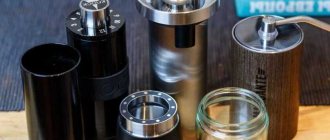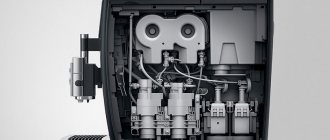Device
All coffee grinders are divided into two types according to the grinding method: burr grinders and rotary screw grinders. There are also differences between manual and electric, but the latter have firmly and thoroughly supplanted their mechanical counterparts.
What does a rotary electric coffee grinder consist of:
- frame,
- metal bowl,
- two-, less often four-blade propeller,
- transmitting rod,
- motor and wire
- lid.
This is how both expensive and cheap models are designed: “Bosch”, “Mikmah”. Soviet electric coffee grinders were also assembled in the same way.
To disassemble them, you need to follow these steps:
- Remove the cover.
- Detach the bottom. In Soviet devices it is fixed with screws using a Phillips screwdriver; in modern devices it is usually simply pryed off and removed.
- Tighten the locking screw in the center with a screwdriver.
- Carefully unscrew the rotor screw with your hand or a pair of narrow-nose pliers (in the same direction in which it grinds the coffee).
- Remove the screw and bowl.
- Dismantle the main body.
Important Before disassembling the coffee grinder, it must be disconnected from the power supply.
Burr coffee grinders are generally disassembled according to the same principle.
- Use a screwdriver to pry it off and remove all the turntables.
- Use the same method to disconnect the bottom (it is advisable to get on the 4 stopper teeth).
- Unscrew the 4 screws around the perimeter and remove the top part.
- Remove the coffee tank (cup).
- Remove the remaining grains with a spoon and then with a vacuum cleaner.
- Remove the disc that regulates the grinding (rotating clockwise).
- Remove the upper stationary blade of the millstone.
- For further cleaning, remove the shock-absorbing springs.
Depending on the model and brand, the algorithm will be slightly different; Miss Clean magazine recommends following the instructions for the specific model.
Device structure
Today's electric coffee grinders come in two types: burr and impact. The lion's share of the space in the device body is occupied by the electric motor - up to 80%. The remaining area is allocated for coffee beans. For example, in millstone models, the coffee grinder consists of three sections. The first is filled with a portion of raw materials for processing. In the second, grinding occurs directly. And in the third, finished products are assembled.
Burr coffee grinder
The impact type design has knives. It is they who grind the grains into powder at high rotation speed. Sometimes such a mechanism is called a rotary mechanism. And it only has one hopper that holds the roasted coffee beans. This is where processing takes place. And the ground raw materials are simply poured into another container. In its design, this coffee grinder is very similar to a blender.
Impact coffee grinder
Important! All devices are equipped with motor blocking when the lid is open and overheating protection. Many models have added an additional pulse mode, which, by briefly stopping the engine, helps when crushing harder products. For example, when you need to make powder from sugar.
Rotary coffee grinders often have a timer installed. It is needed to regulate the degree of grinding. The longer the process, the smaller the product yield. In millstone designs, this role is played by the grinding depth regulator. To do this, increase or decrease the gap between the millstones. Unequal grinding fractions are needed to prepare the drink according to different recipes.
Advice! To brew coffee in a cezve, you need to grind the beans into dust. To brew espresso, a coarser grind is required.
How to grind coffee and use the unit correctly
True gourmets of the drink claim that when preparing coffee, the most important thing is its correct grinding. There is a whole science that describes all the nuances of this seemingly simple operation. Due to the fact that the popularity of drinking coffee has recently become enormous, specialized professionals in this field of cooking have emerged. Sometimes their opinions differ. However, when it comes to grinding coffee beans, experts are inclined to believe that proper grinding occurs either in a manual coffee grinder or in an electric one equipped with millstones. A rotary coffee grinder grinds less evenly, and the resulting final product contains particles of different sizes. In addition, at high speeds of the knives, the coffee burns, which leads to a change in its taste.
The grinding time should not be long. As well as the time from grinding to brewing the drink. The longer the coffee is ground, the more essential oils evaporate. Therefore, the optimal grinding time is considered to be no more than 20 seconds.
Over time, the coffee grinder began to be used not only for coffee. You can crush nuts, eggshells, cereals, salt, sugar and other bulk food products in it. For example, at home using a coffee grinder you can make powdered sugar from ordinary loose sugar.
To obtain powdered sugar, you need to load a certain amount of granulated sugar into the coffee grinder container and turn on the engine for a few minutes. To obtain high-quality powder, you need to bring the consistency of the powder to the state of fine dust. For a fragrant smell, add a little vanillin or vanilla sugar.
In culinary practice, powder mixed with fragrant nutmeg is also used. To do this, first grind a well-dried nut, and then add sugar to it and grind it all together.
It is not recommended to grind products that have a persistent odor in the same coffee grinder. For example, you should not crush pepper in it, the persistent smell of which can then be transferred to the coffee drink.
Causes of breakdowns and prevention
The simplest and most common cause of malfunction of any coffee grinder is clogging. Powder and external debris often get under the propeller and get stuck there; in cheap models, they accumulate inside the housing, threatening the motor with overheating.
Sometimes the device refuses to work not because of a breakdown, but because of sensitive sensors. Modern rotary coffee grinders are equipped with fuses that prevent the motor from starting if the lid is not completely closed. If coffee powder gets into the grooves for the spikes, the sensors detect insufficient tightness. Such a gap is often not noticeable to the eye.
If you use the device for purposes other than its intended purpose, for example, grinding salt or pepper, there is a high probability of jamming the rotary screw. Salt also causes rust, which is not at all desirable. To wash the bushing and screw, it is better to use alcohol, which evaporates quickly and does not increase the humidity inside the device.
Burr coffee grinders are more likely to suffer from electronic malfunctions than from clogging. In particular, the capacitor fails - it can be completely replaced if you have a soldering iron and solder in the house; it is not difficult to find an analogue in any radio parts store.
Analysis of the electrical fault of the Zauber Z-490 coffee grinder is in the video below.
There are also complaints on forums that the rotation screw does not unscrew. If it is clogged at the axle or rusted, it is enough to dab it with alcohol and leave it for a while. If the plastic base in which the blades are held is flattened or otherwise deformed, it will either have to be drilled out or a screw/nail fused into it and then removed.
Prevention
To avoid problems, just follow a few simple rules:
- Store the device in a dry place, do not wash, but only sweep or wipe.
- Clean the device from time to time (small ones with a brush or brush, large ones with a vacuum cleaner and a brush), this is vital for millstone models; semi-professional devices need general cleaning every 2000 servings.
- Do not exceed the permissible load, this applies to both the volume of loaded grains and the duration of one grinding session. The instructions for most rotary coffee grinders indicate a limit of 2-5 seconds, after which the device needs to “rest” for the same amount of time.
- Use the device only for its intended purpose.
Modern coffee grinders are often more powerful than Soviet ones, but are inferior to them in terms of durability, especially when it comes to rotary ones. Millstones are designed for more frequent use, but, as practice shows, they are often let down by electronics. Today there are many service centers ready to service the coffee grinder, but if you follow simple rules, the unit will last a long time without repair.
Rules for operating and maintaining coffee grinders
In order for the coffee grinder to work as long as possible, you need to follow simple operating and maintenance rules.
- Do not leave ground coffee in the device for a long time.
- After each grinding, wipe the inner bowl and knives with a damp cloth.
- The device should not be immersed in water when washing; it is better to limit it to wet wiping.
- Machines with plastic housings may overheat and fail during long continuous operation. Such failures are common in the Moulinex and Saturn brands. If you take short breaks in grinding every 20 seconds, you can increase the life of the coffee grinder.
- You should try to avoid chopping other foods. This is what a blender is for.
- Dull knives and millstones should be replaced promptly. The latter must be replaced after grinding 300 kg of grains, and the former - much more often.
By following simple rules for the care and operation of the device, regularly carrying out preventive maintenance and promptly performing minor repairs, you can extend the life of your favorite coffee grinder, which will delight you with many more years of faithful service.
How to fix problems of the second category
Problems of the second category represent damage to the electromechanical part of the coffee grinder.
| Types of coffee grinder malfunctions | Remedies |
| Broken power cord or poor contacts in the socket. | Using a voltage indicator, find the location of the power failure. The current is restored, the contacts are cleaned, and the junction is isolated. |
| Damage to the switch and jamming of the engine blocking drive. | The faulty switch is removed from the device body and a new one is installed in its place. The engine blocking drive with the cover open is thoroughly cleaned and its free movement is checked. |
| Interruptions in engine operation. Short-term changes in the speed of rotation of the working shaft. Stops when the start button is on. | The brushes may wear out and need to be replaced. Engine manifold contamination. The collector is cleaned and wiped with a cloth soaked in cologne or alcohol. |
More complex repairs associated with rewinding the windings of electric motor coils are, as a rule, not justified and require a lot of time. It's easier to replace the entire motor.
A common and characteristic failure of coffee grinders is the failure of bearings. Although they are protected by special rubber boots, during grinding fine dust still penetrates onto their working surface. This leads to jamming of the electric motor armature. The problem is easily solved - the bearings are cleaned and lubricated with some mineral oil. After this, they can last for a very long time.
The choice of coffee grinder depends on the purpose of its purchase and the volume of planned processing of coffee beans. Coffee grinders from such world-famous companies as Krups, Bosch, Scarlett, Delonghi have proven themselves well. Professional units are capable of passing large quantities of coffee through themselves, while household ones are designed for preparing a coffee drink within the family circle. They also differ in weight, power and other performance indicators. When choosing, you should also take into account the dimensions of the machine, which in some models reach 2.4 m.
Possible problems in the operation of the coffee grinder and ways to eliminate them
Common breakdowns include damage to the switch, reduction in operating speed, or stopping of the electric motor. The cable may become deformed during operation. The knives become dull, reduce the grinding speed and require replacement. Therefore, spare parts for coffee grinders are regularly updated.
In rotary type devices, it is necessary to replace the crushing knife. In devices with millstones, they are regularly sharpened or new millstones are installed. Many devices can be repaired yourself.
Power cable failure and interlock failure
The cable malfunction is visible during operation. If the wire is close to the housing, you will need to unscrew the cover and check the serviceability of the element. The broken cable is replaced.
The locking mechanism in the coffee grinder may not work. Failure occurs when the pressure device on the surface of the lid becomes clogged. If there is no pressure on the inner plate, check the locking using a thin screwdriver. If there is a contact in the device, you need to disassemble the coffee grinder, clean it from dirt and repair the wires leading to the blocker.
Coffee grinder won't start
The device may not start if the internal cable is broken. For repairs, you will need a soldering iron that can be used to repair the loose contact. The structure is first disassembled.
The device does not start due to a breakdown of the electric motor. It is recommended to consult with specialists about the need for repairs. In some cases, completely replacing the mechanism or purchasing another coffee grinder will do.
The knife rotates unevenly
During prolonged use, the knife rotates unevenly. It is necessary to diagnose the operation of the mechanism, because will need adjustment or repair.
As the volume of grains for grinding increases, the speed of rotation of the cutting elements may decrease. The likely cause is dried out bearing grease. The device must be disassembled and lubricated. The causes of failure are also burnout of the winding or failure of the electric motor.
The knives are dull
Knives are among the main elements of the grinding apparatus, because... affect the speed and quality of grain grinding. If the cutting surface of the mechanism is damaged, the processing of coffee beans will be of poor quality.
To determine the cause of the breakdown, it is recommended to have it diagnosed by service center specialists. If there is a manufacturing defect, you can replace the cutting elements of the device. Knives that become dull due to frequent use are sharpened or replaced with new ones.
When working there is a burning smell and the engine knocks
The appearance of a burning smell and the knocking of the coffee grinder motor indicates oxidation and contamination of the sliding bushings and bearings. Breakdown is one of the common malfunctions of electric coffee grinders. It will be necessary to disassemble the system and diagnose the sliding stroke of the elements. If necessary, parts of the device are lubricated.
Rust can be cleaned with special anti-corrosion compounds. The metal elements are pre-treated with sheets of fine-grained sandpaper. Sanding is done carefully, because... It is undesirable to change the gap in the bushing, which will lead to malfunctions of the device.
If a burning smell appears, you should try cleaning the bearings and sliding bushings
How to disassemble
Coffee grinder devices have a simple disassembly scheme that anyone can handle. The main thing is to study the sequence of the algorithm.
All coffee grinders come in two types:
- with a knife device;
- burr mills.
Models with a millstone device have a separate mechanism for disassembling the grinding mechanism. Moreover, each model may have a different parsing process. But they have common features:
- It is worth paying attention to the fact that the devices have conical knives attached to the drive shaft with 3-4 bolts. They can be easily unscrewed with a screwdriver;
- When reassembling, it is important to ensure that the bolt heads fit exactly into the seats;
- If the bolts are loosely tightened and not fully tightened, this may subsequently lead to failure of the device. Also, small metal particles will constantly be detected in the grinding, this may be due to the fact that the protruding parts of the fastening elements will be in the area of movement of the grinding device;
- Disassembling the casing of coffee grinders is quite simple. To do this, several screws are unscrewed on the lower plane, at the bottom of the device. Access to the mounting components may be open or may be blocked by the legs of the device;
- a separate group of grinders may have latches. To do this, you should use special probes or screwdrivers, with which you can bend the latches.
Engine
An important part of the device is the motor. In order to dismantle and inspect this element, it is recommended to remove the knives. They can be removed using several methods:
- When the knife moves clockwise, a left-hand thread is usually applied to the joint surface. To remove, a screwdriver is placed in a special slot and turned clockwise;
- When the knife moves counterclockwise, the connection has a right-hand thread. Accordingly, the screwdriver probe is also placed in the slot and turned counterclockwise.
Engine and knife
Over a certain period of time, the fastening part becomes clogged with particles from grinding. It can also be negatively affected by oxides. To remove all this, you should use special lubricants; these products can also make the process of unscrewing the knife blocks much easier.
If the clamping nut has a conical thread and is made of bronze metal, then it is worth warming up the area with the connection a little. You can use a soldering iron to warm it up.
The subsequent process may depend on the grinder model. In any case, disassembling the device must be careful and accurate, during it it is necessary to monitor the limiters, all elements must be correctly removed from the grooves.
After the knives are removed, you only need to perform a few steps:
- The fixing nut from the plastic base is unscrewed. It provides fastening of the grinding glass;
- When unscrewing the fastener, you should keep an eye on the felt base gasket. Under no circumstances should it be lost;
- then the axle washer, which is made of a metal base, is removed;
- then the blocker plate is removed. To do this, it is carefully pressed downwards and removed from the area with restrictive grooves.
Typically, for most models of coffee grinders, the disassembly process ends with removing the dirt washers and dismantling the power cable and switch. Often, during the process of disassembling the device, it can be revealed that the breakdown occurred precisely because of the washer, for example, it burst or completely collapsed.
Repairing a coffee grinder is not difficult, the main thing is to properly disassemble the device. During disassembly, the sequence must be followed, which will also need to be followed during the process of putting the device back together.
If during disassembly it is revealed that some element is broken or destroyed, then it is better to find out the details of the component parts for the coffee grinder model; this can be found on the Internet or in the instructions. Then you can go to a store or market to purchase the part exactly by number and series.
How to quickly and without damaging the device disassemble the Soviet ZMM coffee grinder
Soviet manufacturers of household appliances for the kitchen tried to make them as functional and easy to use as possible. The ZMM coffee grinder, even after many years of operation, performs its functions perfectly, but if problems arise, the device can be disassembled. This should be done in the following sequence:
- Remove the knife using a screwdriver - insert it into the slot on the bottom of the device and unscrew the part in a smooth counterclockwise motion.
- Unscrew the plastic nut by turning the pliers counterclockwise 90 degrees.
- Remove the glass and plastic cup holder.
- With a gentle movement, remove the metal washer from the axis holding it.
- By simultaneously pressing the fixing plate and the lock, the parts are also turned counterclockwise and the platinum is removed (after it comes out of the grooves).
- Next, you need to remove the power button after the locking spring is bent.
- Remove the mud washer from the axle.
- — Release the wire after performing the following manipulations: bend the ring at the bottom of the ZMM coffee grinder body, unscrew the two screws securing the electrical wire.
- Remove the device motor.
Coffee grinder ZMM
The technology for disassembling the ZMM coffee grinder is somewhat reminiscent of opening the Mikma Ekma IP-30. Some models of coffee grinders are not recommended to be disassembled at home at all. One of these models is considered to be Vitek 1540. The only thing that can be done with this device is to disconnect it from the power supply and thoroughly clean the inner surface and knives. The manufacturer recommends doing everything else at a service center or in the office of a qualified technician.
Disassembling the Russian coffee grinder Mikma IP 30
Most uninformed buyers fail to disassemble the IP-30 coffee grinder from a Moscow company the first time.
You can correctly disassemble the Ekma coffee grinder in the following sequence:
- Remove the plastic cover.
- Hold the impact mechanism splitter with one hand, and with the other hand take a screwdriver and smoothly unscrew the screw on the bottom of the coffee grinder.
- Remove the divider.
- Use pliers to turn the plastic holder (from right to left and vice versa) located inside the metal bowl.
- Remove the holder from the bowl.
- Remove the protective clip and bowl from the device body.
- Turn the metal bar from right to left and separate it from the grooves of the coffee grinder body.
- Pull out the contact from the base of the power button, carefully move it to the side, and remove the electric motor from the housing.
- Remove the oil seal from the engine shaft and the rubber shock absorbers from its shields.
- — Inside the case, remove the spring that controls the operation of the turning button and remove the button.
- Release the power cord by first unscrewing the screws securing the bar.
The technology for disassembling the Mikma Ekmu IP-30 coffee grinder is quite complex, so at home it is better to do it using the video example.
Manufacturers of household appliances use a variety of technologies. Most devices are characterized by high strength and tight fastening of parts. For example, it is precisely because of the manufacturing technology that it is difficult to disassemble a Bosch coffee grinder (model Bosch MKM-6000), while its analogue, the Belarusian model Vitek 1540, can be opened in a few minutes.
Bosch
Perhaps the easiest way to disassemble of all coffee grinder samples is the Bosch mkm-6003 model. The algorithm of actions is as follows: to remove the knife, you just need to unscrew it clockwise, and you can pull out the motor by loosening the power cord and pulling the motor towards you. That's all.
One person can no longer handle the Bosch mkm-6000 model. Need outside help or access to a good vice. First, you need to fix the unit in the hands of an assistant or clamp it in clamps so that it is strictly horizontal. Next, use a screwdriver or feeler gauge to pry up the bottom in the area where the power cord is attached. Then, having driven the first screwdriver to a depth of one centimeter, the second one needs to feel for the latches and carefully separate them. In this case, you should hold the bottom so that the motor, which is pressed against it, does not fall out. The apparent simplicity of the process should not be misleading, since the main difficulty lies precisely in the latches, the separation of which requires great skill and patience.
Coffee grinders from other brands
Basically, all coffee grinders are easy to disassemble. Usually it is enough to unscrew 2-3 screws from the bottom of the case. Sometimes you have to tinker with the latches. But there are also secrets, like the Bork j700 model: to get to the printed circuit board, you need to remove the grind switch knob, which is secured with a washer instead of a nut (it is this that needs to be unscrewed). The original opening is also typical for the Elmaz coffee grinder. The nuance is that you first need to turn the bottom with your palm, and then remove it from the hooks in the body.
Advice! Special mention can be made for the Vitek 1540 model. It is not recommended to disassemble it at home. This can only be done by qualified service technicians.
Electric coffee grinder repair
Composition and types of electric coffee grinders.
Main parameters of impact electric coffee grinders (ECMU) and millstone grinders (ECMZh)
Nominal capacity of coffee beans, g
Grinding time, s, no more
Rated power consumption, W, no more
Electric coffee grinder EKMU-50
In the EKMU-50 impact electric coffee grinder, coffee beans are broken by a two-bladed knife rotating at high speed (Fig. 1). An electric motor with an interference suppression device is installed in the plastic casing of the coffee grinder. The engine is mounted on rubber shock absorbers to reduce engine noise while grinding coffee beans. The coffee grinder is equipped with a locking device that turns off the motor when the lid is opened. During operation of the device, the engine may shut down due to loosening of the contacts in the locking device or the switch button.
Rice.
1 Design of the EKMU-50 electric coffee grinder
- Electric motor;
- Bowl
; - Knife;
- Lid;
- Button;
- Pusher
Disassembling the coffee grinder begins by unscrewing the motor armature of the two-bladed knife. For this purpose, a screwdriver is inserted into the hole in the bottom of the housing, where the slot is located at the lower end of the motor armature. Holding the shaft with a screwdriver, turn the two-bladed knife in the direction it rotates when the coffee grinder is operating and unscrew it. Under the blade in the bean cup there is a hexagonal plastic seal head that protects the grinder from ground coffee getting into it. Take a socket wrench of the required size and unscrew the head counterclockwise. Remove the press veneer gasket located under the bowl and gain access to the engine mount. Press on the bracket that presses the engine through the rubber shock absorbers towards the bottom of the coffee grinder body, and by slightly turning this bracket in any direction, release the engine. The engine is removed from the housing along with the locking device. In the event of a malfunction of the commutator motor (for example, strong sparking of the brushes), diagnostics and troubleshooting are described in detail in the article repairing a vacuum cleaner
.
The commutator motors of an electric coffee grinder and a vacuum cleaner differ only in power and, accordingly, in size. All their structural components are the same. Assembling the coffee grinder is carried out in the reverse order.
Electric coffee grinder EKMZH-125
The EKMZH-125 electric coffee grinder is a millstone-type device (Fig. 2). Coffee beans are ground between two millstones: movable and non-movable. The movable millstone is driven by an electric motor. The coffee grinder is turned on by pressing the microswitch button. The degree of grinding of the beans is regulated by turning the regulator knob located under the coffee grinder body.
Rice. 2 General view of the electric coffee grinder EKMZH-125
- Cord storage device;
- Lid;
- Fixed millstone;
- Grain hopper;
- Movable millstone;
- Hopper for ground coffee;
- Electric motor;
- Regulator;
- Noise suppression device
Rice.
3 Schematic diagram coffee grinder EKMZH-125
- C1 - capacitor 0.25 μF;
- C2 - capacitor 0.01 μF;
- C3 - capacitor 0.01 μF;
- M - electric motor DK 65-60-10;
- L1, L2 - chokes;
- S1 - locking device;
- S2 - microswitch;
The main malfunctions of coffee grinders and how to fix them
Type of coffee grinder malfunction
Remedy
When writing the article, some of the materials from the book by V.M. Pestrikov were used. “Home electrician and more. »
Source










